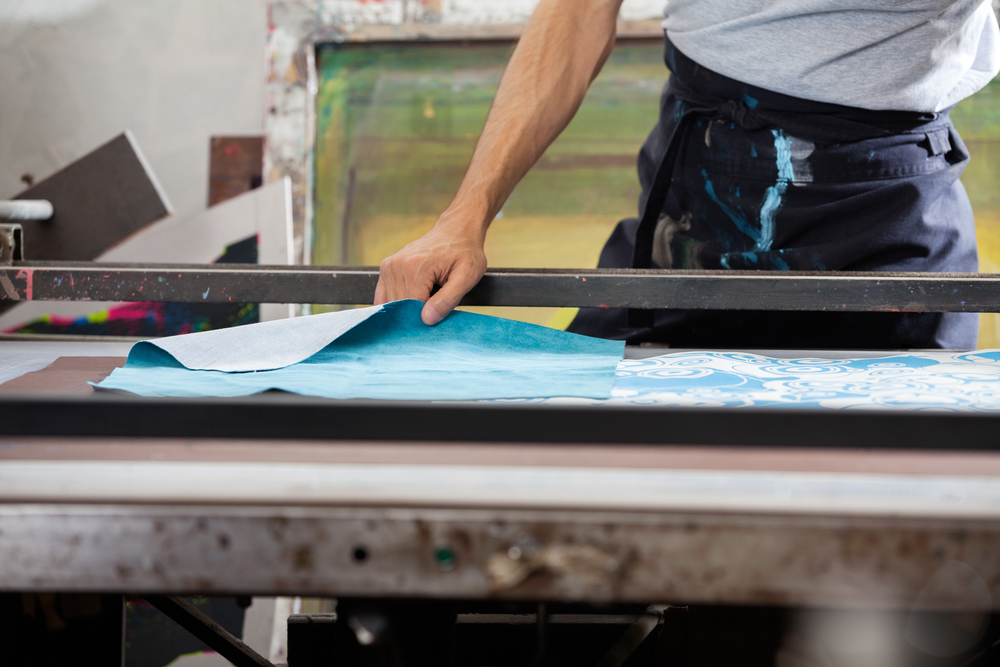A Closer Look at Inks: The Science Behind Screen Printing Colors and Their Durability

Posted by Naji Jr. on to Technical Guides
A Closer Look at Inks: The Science Behind Screen Printing Colors and Their Durability
In today's digital age, the traditional art of screen printing still stands tall, thanks in part to the depth and durability of the colors it produces. But have you ever paused to ponder the science behind those vibrant hues? Dive into the world of inks and discover the fascinating nexus of chemistry, technology, and artistry that gives screen printing its enduring charm.
Table of Contents
1. The Basics of Screen Printing
2. The Chemistry Behind the Colors
3. Factors Affecting Color Durability
4. Enhancing the Lifespan of Screen-Printed Colors
5. Final Thoughts
1. The Basics of Screen Printing: An Insight into the Artistry and Technique
Screen printing, also known as silk-screening, has graced our world for centuries, with its origins tracing back to ancient China. To truly appreciate the nuances of this craft, it's vital to delve into its core principles and processes. Let's embark on this journey, exploring the mesmerizing world of screen printing.
Historical Roots
The craft of screen printing began in Asia and slowly made its way to Europe, garnering acclaim for its distinctive prints and textures. It wasn't merely a printing method but an art form, with intricate patterns symbolizing cultural stories and legends.
The Screen Printing Process: A Step-by-Step Guide
1. Design Creation: The journey starts with a design, often crafted digitally today. The complexity can range from single-color motifs to multicolored masterpieces.
2. Prepping the Screens: Each color in the design requires a unique screen. A mesh screen, often made of polyester, is stretched over a frame. The tighter the mesh, the more intricate the details that can be achieved.
3. Applying the Stencil: The design is transferred to the screen using a light-sensitive emulsion. Once exposed to light, the emulsion hardens, and the unexposed areas (forming the design) are washed away, leaving a stencil.
4. Ink Application: With the stencil ready, the screen is placed over the substrate. Ink is then spread over the screen and pressed through using a squeegee. The ink flows through the open areas of the stencil, transferring the design onto the substrate.
5. Curing the Print: Once printed, the ink needs to be set, ensuring it won't wash or rub off. This curing process often involves heating the print to a specific temperature.
Diverse Applications
Screen printing's versatility has led to its adoption across various industries. From fashion apparel and posters to ceramics and electronic circuit boards, the potential applications are endless.
Why Screen Printing Stands Out
In a digital age where automated printing reigns supreme, screen printing offers a tactile depth and a unique touch. The inks used in screen printing are typically thicker than those in digital printing, leading to vibrant, lasting colors that pop. Moreover, the ability to layer inks gives designs a textured feel, elevating the sensory experience.
2. The Chemistry Behind the Colors: Unveiling the Secrets of Screen Printing Inks
As with many art forms, the brilliance of screen printing doesn't merely lie in the final product but also in the science and chemistry that power its creation. Let's embark on an enlightening journey, deciphering the intricate elements that constitute screen printing inks and the magical hues they produce.
The Alchemy of Pigments
Pigments form the foundation of any ink, imparting them with color. But what truly are these mystical elements?
- Nature of Pigments: Essentially, pigments are fine, powdered substances that, when mixed with a liquid, impart color to it. These aren't soluble, meaning they don't dissolve but rather stay suspended in the liquid.
- Organic vs. Inorganic Pigments: While organic pigments are carbon-based and often derived from plant or animal sources, inorganic ones come from minerals and metals. Organic pigments tend to offer brighter colors and superior tinting strength, while inorganic variants are praised for their stability and durability.
Binders: The Binding Force Behind Vivid Designs
Just having pigments isn't enough. They need to stick to the substrate, and that's where binders come into play.
- Role of Binders: Think of binders as the 'glue' holding the pigment to the fabric or paper. They envelop pigment particles, providing a cohesive structure and ensuring the pigment's adhesion to the substrate post-printing.
- Types of Binders: The world of binders is diverse. While water-based binders are eco-friendly and offer a soft finish, plastisol binders (PVC-based) are known for their durability and vividness. Solvent-based binders, on the other hand, provide flexibility in applications but come with environmental considerations.
Solvents: The Unsung Heroes
Though they eventually evaporate and disappear, solvents play a crucial role in screen printing inks.
- Functionality of Solvents: They ensure the ink maintains a consistent, workable viscosity, making it easier to press through the mesh screen.
- Evaporation and Curing: As the printed design is cured, the solvent evaporates, ensuring the ink's consistency remains optimal for adherence.
Decoding Colorfastness in Screen Printing
The term 'colorfastness' often floats around in the screen printing world, but what does it truly denote?
- Essence of Colorfastness: It gauges an ink's resilience against fading or color bleeding when subjected to various external conditions like sunlight, washing, or friction.
- Key Determinants: The stability of the chosen pigment, the efficacy of the binder in anchoring the pigment, and the synergy between the pigment and substrate collectively dictate the colorfastness of a screen print.
3. Factors Affecting Color Durability: Unmasking the Challenges in Screen Printing Longevity
A hallmark of screen printing is the depth and endurance of its colors. However, like every masterpiece, screen-printed designs face threats from various external elements. Let's dive deep into the factors that challenge the durability of these printed hues and understand their intricate interplay.
1. The Battle Against Ultraviolet (UV) Rays
The sun, while vital for life, poses a considerable threat to the vibrancy of screen-printed colors.
- UV Rays and Pigments: On a molecular level, UV rays penetrate the structure of pigments, weakening and breaking their chemical bonds. This process, called photodegradation, directly impacts the color intensity, leading to fading.
- Protection Against UV: Many modern inks incorporate UV stabilizers and absorbers. These additives diminish the rate of UV absorption, thus prolonging the life of the printed design.
2. Mechanical Abrasion: The Wear and Tear Challenge
Physical forces, especially when recurrent, can erode the very layers of the printed design.
- Effects of Regular Washing: With each wash, especially in harsh conditions, the fabric's fibers expand and contract. This movement can strain the ink, leading to cracks or peeling over time.
- Impact of Friction: Constant rubbing, whether from usage or during washing, removes the microscopic layers of ink, reducing its luster and eventually causing noticeable wear.
- Preventive Measures: Opting for gentle wash cycles, using milder detergents, and minimizing high-friction activities can help maintain the design's integrity.
3. The Invisible Threat: Chemical Exposure
It's not just the physical world that screen prints battle; chemicals, often unbeknownst to us, can jeopardize the print's vibrancy and longevity.
- Household Chemicals: Everyday products like bleach or certain cleaning agents can react adversely with screen-printed designs. These chemicals can alter the molecular structure of pigments, leading to discoloration.
- Chlorine's Impact: A common culprit, especially for swimwear, is the chlorine in pools. Chlorine can bleach colors and weaken the binder's grip on the substrate.
- Counteracting Chemical Effects: It's wise to rinse chlorine-exposed garments immediately and avoid direct contact with harsh chemicals. Furthermore, reading care labels can guide users on keeping their screen-printed items pristine.
4. Enhancing the Lifespan of Screen-Printed Colors: Tips and Best Practices
Screen-printed designs are a blend of art and chemistry. However, to ensure these designs continue to shine vibrantly through the years, it's imperative to know how to care for them. In this guide, we'll delve into the strategies that can significantly amplify the longevity of screen-printed colors.
1. The Crucial Role of Proper Curing
The curing process is the linchpin in the screen printing lifecycle, cementing the ink's relationship with the substrate.
- Understanding Curing: At its essence, curing is the process of heat-setting the ink post-printing. This step ensures the ink's elements bond firmly with the material, be it fabric, paper, or any other substrate.
- Optimal Curing Conditions: Each ink type comes with a specific curing temperature and duration, often detailed by the manufacturer. Adhering to these specifications is paramount. Under-curing can leave the ink susceptible to washing off, while over-curing might lead to brittleness and cracking.
2. Battling the Sun with UV Protective Measures
Continuous exposure to the sun can be a screen print's nemesis. However, armed with UV protective tools, one can significantly mitigate this challenge.
- Inbuilt UV Inhibitors: Modern screen printing inks often incorporate UV inhibitors, chemicals designed to absorb or reflect UV radiation, thereby minimizing the damage to the pigments.
- Post-Print UV Protective Sprays: If the ink lacks inherent UV protection, fear not. Several UV protective sprays available in the market can be applied post-printing, forming a protective shield against harmful sun rays.
3. Gentle Care: Treating Your Screen Prints with Love
TLC (Tender Loving Care) isn't reserved for living beings alone. Your screen-printed items will thrive with a bit of attention and care.
- Washing Protocols for Apparel: Turning garments inside out shields the print from direct abrasion against the washing machine's walls. Using cold water preserves the ink's integrity, and mild detergents ensure harsh chemicals don't assault the print. Bonus tip: avoid fabric softeners, as they might affect the ink's finish.
- Drying Guidelines: While machine drying might seem convenient, it can be brutal on screen prints. The intense heat and tumbling can weaken the ink's bond. Instead, air drying in a shaded area maintains the design's vibrancy and structural integrity.
5. Final Thoughts
The captivating world of screen printing inks melds science and art in a symphony of colors. By understanding the intricacies of the inks and the factors that influence their durability, we can appreciate the beauty of screen-printed designs even more and ensure their longevity.
By tapping into the science behind screen printing, we not only demystify the process but also optimize it, leading to designs that last, captivate, and inspire.
Categories
Recent Posts
- The Best Custom Polos for Workwear and Events
- The Most Popular Custom Hats for Every Occasion
- Why Choose a Mesh Back Hat?
- Exploring Backstrap Options: The Benefits and Drawbacks of Popular Hat Closures
- The Perfect Pair: Branded Bills Hats for Embroidery
- Trendy Camo Hats for the Outdoors: Customize the Richardson 111P with LogoUp
- The Ultimate Guide to Customizing the Richardson 320 Washed Chino Hat with Embroidery
- Embroidery on the Otto Cap 39-165: High-Performance Customization for Every Occasion
- LogoUp Holiday Gifts: Embroidered and DTF-Decorated Richardson 112, 112PFP, and 112PM
- Gifting LogoUp Custom Campfire Mugs: Thoughtful, Versatile, and Personalized















































































Add Comment